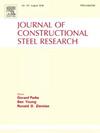可更换开法兰梁段节点的抗震性能研究
IF 4
2区 工程技术
Q1 CONSTRUCTION & BUILDING TECHNOLOGY
引用次数: 0
摘要
为实现地震作用下塑性铰的外移和地震后结构的快速修复,提出了一种可更换开法兰梁段节点。该节点是基于弱化截面和可替换性的概念设计的。在低周往复荷载作用下对节点进行抗震性能试验,得到节点的滞回曲线、骨架曲线、延性系数、耗能能力和刚度退化曲线。利用有限元软件对该节点进行了不同梁柱截面尺寸开孔直径参数的分析。结果表明:该节点可使梁端塑性铰向外移动至可替换梁段的开口弱化处,具有良好的承载力、延性和震后可修性;随着可替换梁段开孔直径的增大,节点的延性、耗能能力和刚度逐渐降低,但仍能满足抗震性能的相关要求。因此,建议开孔直径为梁缘半宽的0.2-0.35倍。改变梁柱截面尺寸后发现,只要保证开孔直径在梁翼缘半宽的0.2 ~ 0.35倍之间,不同梁柱截面尺寸的节点仍能满足抗震性能的相关要求,极限承载力下降不超过10%。本文章由计算机程序翻译,如有差异,请以英文原文为准。
Seismic performance of a joint with replaceable flange-opening beam segment
To realize the outward movement of plastic hinges under earthquake action and the rapid repair of the structure after earthquakes, a joint with replaceable flange-opening beam segment (JRFOBS) was proposed. The joint was designed based on the concepts of weakened section and replaceability. The joint was tested under low-cycle reciprocating loading to study the seismic performance, and the hysteresis curve, skeleton curve, ductility coefficient, energy dissipation capacity and stiffness degradation curve of the joint were obtained. With the help of finite element software, this joint was analyzed by variable parameters of opening diameter of different beam-column section sizes. The results show that the joint can make the plastic hinge of the beam end move outward to the opening weakening of the replaceable beam segment, and has good bearing capacity, ductility and post-earthquake repairability. With the increase of the diameter of the openings in the replaceable beam segment, the ductility, energy dissipation capacity and stiffness of the joint gradually decrease, but they can still meet the relevant requirements of seismic performance. Therefore, it is recommended that the opening diameter is 0.2–0.35 times the half width of the beam flange. After changing the beam-column section sizes, it is found that as long as the opening diameter is ensured to be between 0.2 and 0.35 times the half width of the beam flange, the joints with different beam-column section sizes can still satisfy the relevant requirements of seismic performance and the ultimate bearing capacity decreases by no more than 10 %.
求助全文
通过发布文献求助,成功后即可免费获取论文全文。
去求助
来源期刊

Journal of Constructional Steel Research
工程技术-工程:土木
CiteScore
7.90
自引率
19.50%
发文量
550
审稿时长
46 days
期刊介绍:
The Journal of Constructional Steel Research provides an international forum for the presentation and discussion of the latest developments in structural steel research and their applications. It is aimed not only at researchers but also at those likely to be most affected by research results, i.e. designers and fabricators. Original papers of a high standard dealing with all aspects of steel research including theoretical and experimental research on elements, assemblages, connection and material properties are considered for publication.
 求助内容:
求助内容: 应助结果提醒方式:
应助结果提醒方式:


